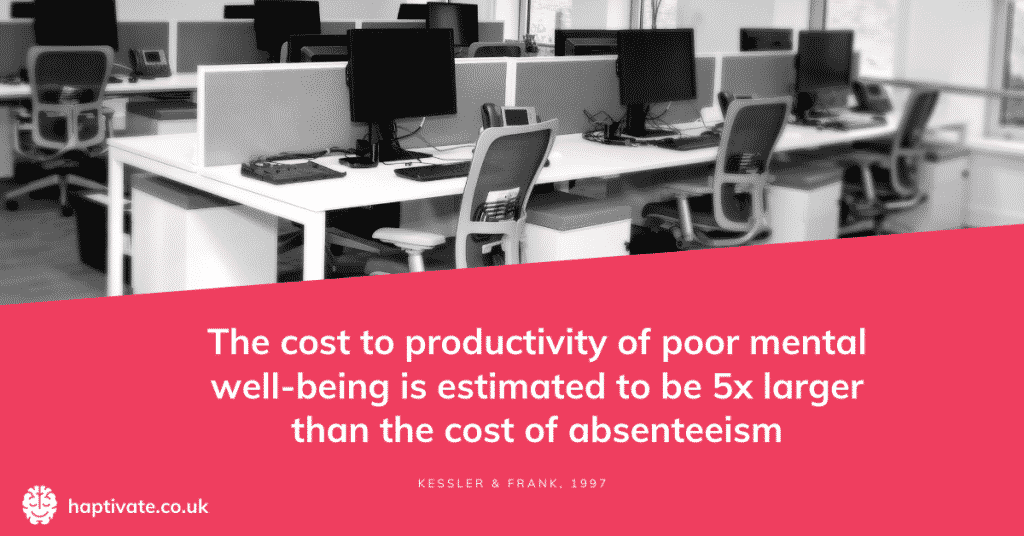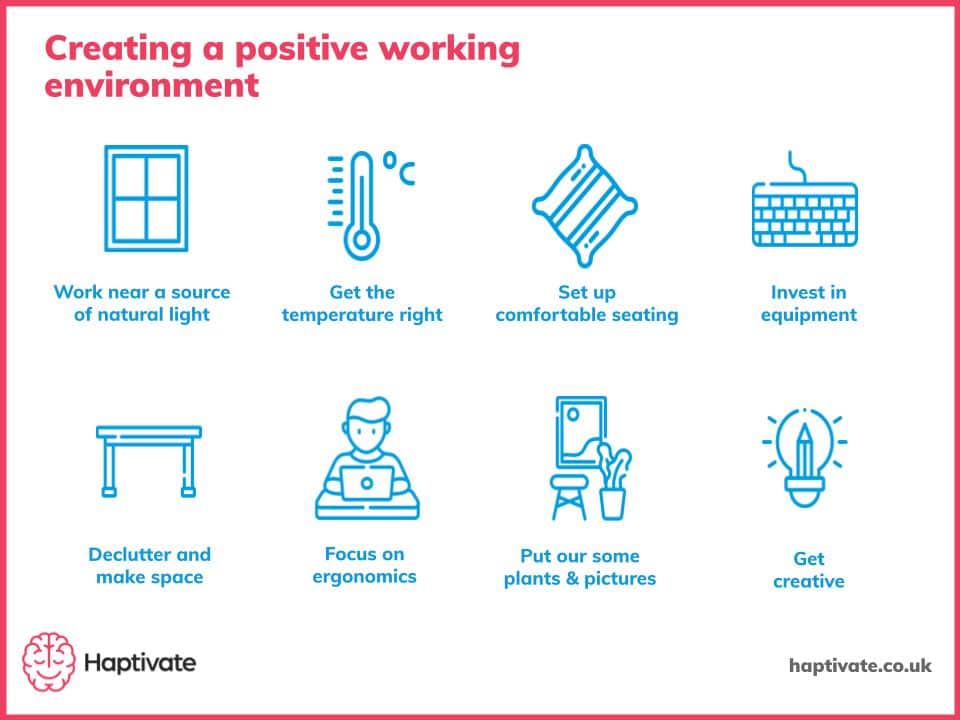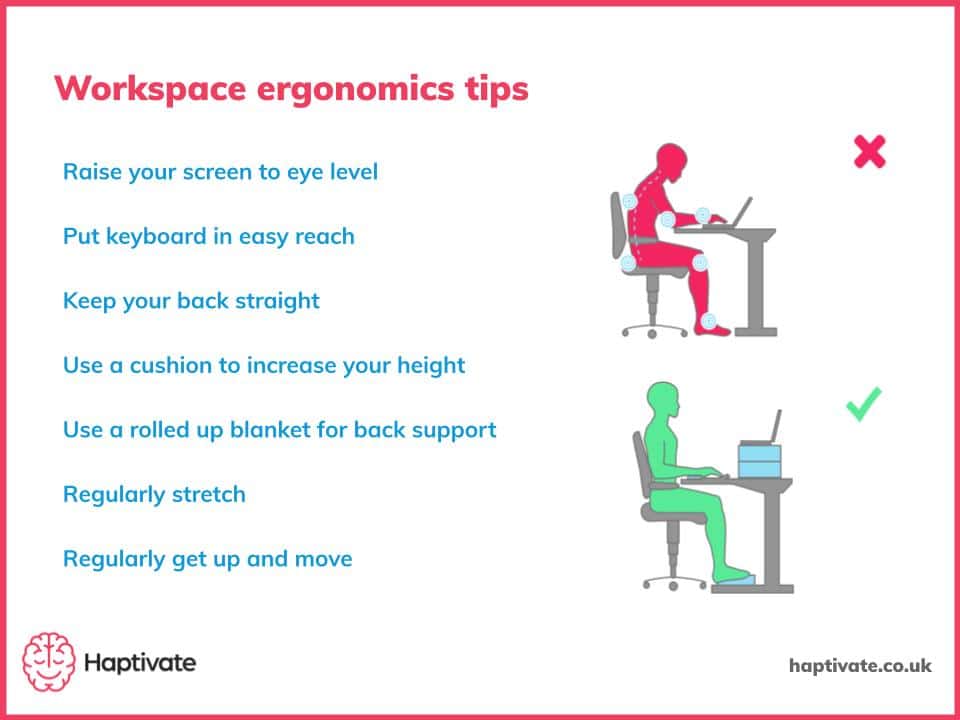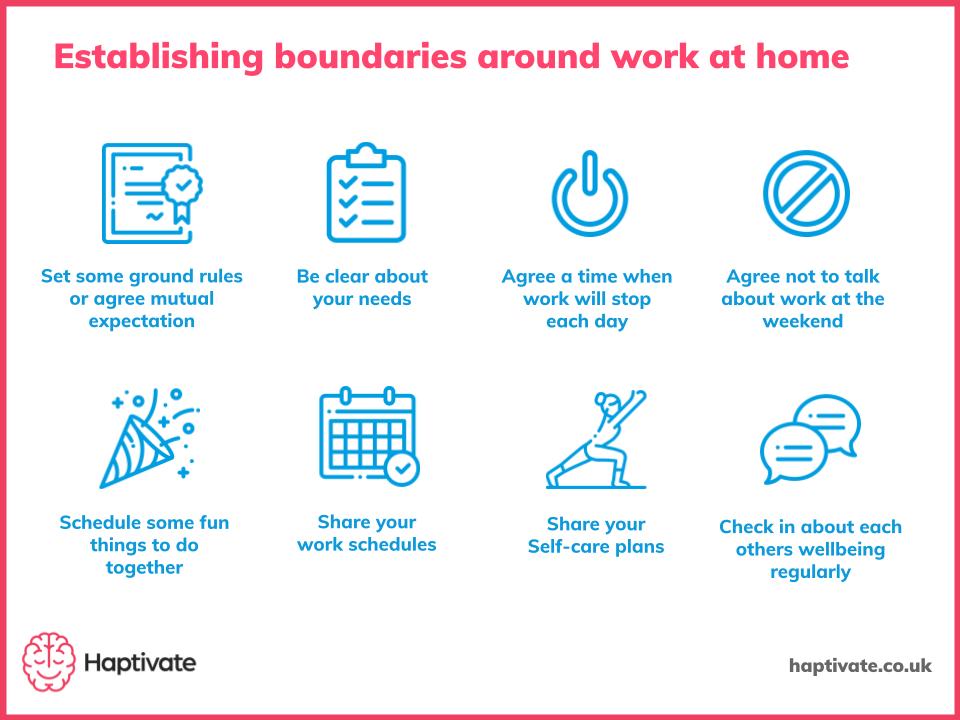Work from Home Wellbeing Ideas: Nurturing Balance and Wellness in a Remote Environment

You’ve been working from home for what feels like an eternity. Your bed is now your desk, your living room is your lunch break room, and your colleagues are now just faces on a screen. You’re forever juggling work and personal life, and your mental health has taken a hit.
Sound familiar? You’re not alone!
The pandemic changed everything. Remote and hybrid work has become the new normal. And with this comes a whole new set of work challenges, especially when it comes to maintaining our wellbeing.
We’re here to help you solve those remote worker wellbeing challenges. In this blog, we’ll share a host of practical tips and tricks to boost your productivity, motivation, and most importantly, your wellbeing when working from home.
Whether you’re a team leader looking to support your remote employees or someone working from home looking for guidance, we’ve got you covered. So, let’s dive in!
Table of Contents
The Good, the Bad, and the Ugly of Remote Working
Remote working has become more prevalent than ever before – and it’s not all sunshine and rainbows. While there are plenty of benefits to working from home, there are also some downsides to consider. Here are some of the pros and cons of remote working:
The Good:
- More flexibility over your working hours, allowing you to better balance your work and home life (although a lot of people struggle to do this).
- Reduced commute time. Jump out of bed and straight into your office. Not having to fill up the car or pay for public transport also boosts financial health.
- No more rushing out the door. You can create a morning routine that works for you, whether that’s being able to take your time getting the little ones school, or just having some extra quiet time for yourself.
- Getting to spend more time with family and loved ones, including the ability to provide pet and/or child care during the day.
- Access to a wider range of job opportunities that aren’t limited by geographic location.
- Greater freedom to design your workspace and environment to suit your preferences (no more power struggles over control of the office thermostat!).
The Bad:
- Feeling isolated and disconnected from co-workers can be a real challenge when working remotely.
- The lack of structure and external accountability can feel overwhelming, especially when trying to juggle multiple responsibilities.
- Struggling to set boundaries between work and personal life can lead to longer work hours.
- Missing the office environment and the social interaction that comes with it can be a difficult adjustment for some people.
- It can be challenging to stay productive and focused throughout the working day, due to additional distractions compared to an office environment.
- Dependence on technology can lead to technical issues and communication challenges, making it harder to connect with co-workers and get the support you need.
The Ugly:
- Blurred boundaries between work and personal life can lead to a lack of time for self-care and relaxation. You feel like you’re living at work.
- A lack of face-to-face interaction can lead to miscommunication, misunderstandings, and conflicts.
- A collapse in motivation and focus due to the lack of external structure and accountability.
- Increased risk of burnout due to the pressure to constantly perform and the absence of social support.
- Social isolation, leading to an increased risk of depression and other mental health issues.

Why Workplace Wellbeing Matters
Here’s the deal: just because we’re working remotely doesn’t mean we can ignore workplace wellbeing. In fact, it’s even more important now to pay attention to it.
When we were in the office, we often took for granted how our wellbeing needs were getting fulfilled through routine daily interactions and support. However, in a remote setting, it’s up to us to actively seek ways to support our wellbeing, or else we’re bound to encounter challenges along the way.
So, why does workplace wellbeing matter? It matters because it affects our overall happiness, productivity, and success. By prioritising our wellbeing, we can enhance our work experience, maintain a healthy work-life balance, and foster a positive work environment.
Let’s explore some of the many benefits that workplace wellbeing brings…
1. Mental Health:
When we’re working from home, it’s easy to blur the lines between work and personal life. We might find ourselves working longer hours1, struggling with feelings of isolation2, or dealing with increased stress levels3 and anxiety4. Prioritising mental health and wellbeing is crucial to help us manage these challenges and maintain a healthy work-life balance.
2. Productivity and Motivation:
A healthy and happy workforce is a productive and motivated workforce. Research shows that employees who feel supported and valued by their employers are more likely to be engaged and committed to their work5. This, in turn, leads to increased productivity and better results.

3. Retention and Recruitment:
A company that values its employees’ wellbeing is more likely to attract and retain top talent6. In a remote environment, it can be challenging to create a sense of company culture and values, but prioritising workplace wellbeing can help to build that sense of community and foster loyalty among employees.
4. Physical Health
Prioritising physical health and wellbeing when working from home doesn’t just benefit individuals, it also benefits the organisation as a whole7. When employees take care of their physical health, they are less likely to experience chronic pain or injuries that could lead to more sick days or reduced productivity.
Creating a Healthy and Productive WFH Environment
The environment you work in can have a huge impact on your mental and physical wellbeing. Yup, it’s true! Studies have shown that a workspace that’s poorly designed can lead to increased stress levels, anxiety, and physical discomfort, while a workspace that’s well-designed can increase productivity, creativity, and overall wellbeing8.
And when it comes to working from home, creating a space that’s comfortable and promotes wellbeing is even more important.
Here’s some working from home wellbeing ideas for creating a healthy a productive work environment:

1. Create a Designated Workspace
Creating a designated space that’s free from distractions is crucial to maintaining focus and productivity when working from home. It’s important to set healthy boundaries between your work life and home life, even if you’re working from the same space.
Ideally, your workspace should be in a separate area from your personal living areas, but if that’s not possible, try to create a visual distinction between your workspace and your living space. This can help signal to your brain that it’s time to work when you’re in your workspace and help you switch off from work when you’re done for the day9.
This can also create a sense of separation that can help you stay focused and productive throughout the day. Remember to set healthy boundaries and prioritise your wellbeing, both at work and in your personal life.
2. Choose Comfortable Furniture
Choose comfy furniture: Sitting for long periods can be tough on your back, so get yourself a chair that feels like a cozy hug and helps you maintain good posture. Look for one with proper lumbar support and adjustable features10.
If you’re up for it, give a standing desk a whirl. It lets you switch between sitting and standing, reducing back pain and keeping things interesting. Another option is a balance ball chair, which engages your core muscles and promotes better posture. Find what works for you and prioritise comfort and good posture to make your work setup a happy place for your back.
3. Think About Ergonomics
Poor ergonomics can lead to physical strain and injury. To avoid any discomfort, it’s important to set up your workspace in a way that promotes good posture and reduces strain on your body.
To help prevent neck pain and other physical discomfort, ensure that your computer screen is at eye level and that your keyboard and mouse are at a comfortable height11.

4. Take Breaks and Move Around
It’s easy to get caught up in work and forget about the importance of physical activity. You get stuck into a task and before you know it you’ve been sat down for several hours. But a sedentary lifestyle can have negative effects on our physical health12.
Make a conscious effort to take plenty of short breaks (set a timer if it helps) away from your desk to stretch and move around13. Try and grab some fresh air and go for a walk on your lunch break. It’s a great way to break up the day and give yourself a mental and physical break.
5. Let in Natural Light
Natural light is not only good for your mood, but it’s also essential for promoting our sleep schedule14. Make sure your workspace has access to natural light, and consider adding plants or other natural elements to your workspace to promote a sense of calm and wellbeing.
Maintaining Connection and Collaboration With Remote Teams: Why It Matters
When working remotely, it’s easy to feel disconnected from our colleagues and our company’s mission. The lack of in-person interaction and team bonding opportunities can lead to feelings of isolation, disengagement, and decreased motivation.
Moreover, studies have shown that social isolation can have negative effects on mental health and wellbeing.
However, maintaining a sense of connection and collaboration is crucial, especially when working remotely. Here’s why:
- Boosts employee engagement: Connection and collaboration foster a sense of community and belonging among remote employees. Research has shown that employees who feel connected to their colleagues and their company’s mission are more engaged and committed to their work, leading to better job performance and higher job satisfaction15.
- Enhances innovation16 and creativity17: Collaboration is essential for innovation and creativity. When people work together, they can share ideas, perspectives, and knowledge, leading to new insights and innovative solutions to complex problems.
- Improves mental health: Social support is essential for maintaining good mental health and wellbeing. Maintaining a sense of connection and collaboration can reduce feelings of isolation and increase feelings of social support and belonging18.
So, how can we maintain connection and collaboration with remote teams?
How to Maintain Connection When Remote Working:
1. Use Video Calls
To keep that face-to-face vibe alive even in remote work, video calls are the way to go! Platforms like Microsoft Teams or Zoom make it happen19. Here’s what you can do:
- Schedule team meetings and one-on-one check-ins using video calls. Seeing each other’s faces adds that personal touch beyond text.
- Don’t go overboard! Back-to-back calls can be draining. Take breaks between calls to recharge and avoid burnout.
- Make it social! Use video calls for casual chats and virtual hangouts. Plan “coffee chats” or “happy hours” to catch up on non-work stuff and keep those connections strong.
- Get creative! Use video calls for brainstorming, team-building, or even virtual lunch breaks. Mix things up to keep everyone engaged and motivated.
By embracing video calls and finding the right balance, you’ll foster connection, collaboration, and a sense of togetherness with your remote team. So, grab your webcam, put on a smile, and let’s bridge the distance with video!
2. Leverage Team Collaboration Tools
Use team collaboration tools like Slack, Asana, or Trello to keep everyone on the same page and facilitate communication and collaboration20.
3. Encourage Virtual Team-Building Activities
Plan virtual team-building activities like online games, happy hours, or other fun events that can help remote workers feel more connected and foster a sense of community21.
Additionally, consider hosting wellbeing workshops that provide valuable insights and strategies for maintaining mental and physical wellbeing while working remotely.
By prioritising connection, collaboration, and investing in wellbeing workshops, we can create a more engaged, innovative, and mentally healthy remote workforce. So, let’s stay connected and collaborative, even when working remotely!
Related Workshop: Remote Worker Wellbeing Essentials
Remote teams face unique wellbeing challenges. Employers and employees must be proactive in managing and maintaining wellbeing. Utilising the latest scientific research and best practices from successful remote companies, we’ll explore practical approaches to creating healthy routines, managing isolation and maintaining motivation.
Prioritising Mental Health and Wellbeing in a WFH Environment
When working from home, it can be challenging to maintain a healthy work-life balance and avoid feelings of burnout or stress. Prioritising mental health and wellbeing is crucial for maintaining productivity, motivation, and overall wellbeing.
Here’s a few tips to help you prioritise your mental wellbeing when working from home:
1. Establish Boundaries
Creating a schedule that suits you and being clear with your team about your expectations is super important for maintaining a healthy work-life balance. But there’s more you can do to keep work and personal life separate…

Try using a fun activity as a buffer between your work and home life. For instance, make it a daily habit to take a walk or do something you love at 5 PM. This activity, preferably outside, helps you transition mentally from work to personal time. It’s like a little signal that says, “Work’s done, it’s time to relax and enjoy myself!”
Oh, and don’t forget to flex your “no” muscles! Saying no to requests that eat into your personal time is totally okay. You gotta know your limits and communicate them. Take a moment to evaluate requests that come your way and see if they fit your schedule and energy levels. It’s all about finding that balance and standing up for yourself.
FREE DOWNLOAD: How To Say ‘No’ Cheat Sheet
Set effective boundaries with 12 easy methods of saying no (politely!) when you need to.
PLUS get access to our growing list of free wellbeing at work resources!
2. Take Breaks
Taking regular breaks throughout the day can help you reduce stress levels and increase productivity. Go for a walk22 outside, meditate23, or take some deep breaths24 to clear your mind and recharge your batteries.
3. Practice Self-Care
Prioritising self-care can help you relieve stress and increase feelings of wellbeing. Take some personal time each day to do something you enjoy (even if it’s just 10-15mins), like reading, exercising25, or taking a relaxing bath.
4. Seek Support
Don’t hesitate to reach out to friends, family, or a mental health professional for support and guidance when you’re feeling overwhelmed or stressed. We’ve all been there. You are not alone!
5. Create a Supportive Environment
Decorate your workspace with things that make you happy, like pictures or plants, to create a calming atmosphere. You can also let in natural light or take a quick walk outside to boost your mood.
Staying Motivated and Focused When Working from Home
Let’s be honest – staying motivated and focused when working from home isn’t always easy. With pets, family members, household chores, and other distractions all competing for your attention, it can be a real challenge to stay on task.
Plus, without the structure and accountability of an office environment, it’s all too easy to get sidetracked and fall into unproductive habits. But fear not! With a little bit of effort and some practical tips, you can overcome these challenges and stay motivated and focused when working from home.
So, let’s roll up our sleeves and jump in. With a few helpful strategies in your back pocket, you can maintain productivity, meet deadlines, and stay on track, even in the face of constant distractions.
Top tips to help you stay motivated when working from home:
1. Set Goals
Setting goals can help you stay focused and motivated. Make sure your goals are specific, measurable, and achievable. Break larger goals into smaller tasks to make them more manageable26.
2. Create a Routine
Having a routine can help you establish a sense of structure and routine in your day27. Set a consistent start time and end time for your workday, and include breaks and other activities in your schedule.
3. Eliminate Distractions
Distractions can be a major productivity killer28. Try to eliminate or minimise distractions by turning off notifications on your phone or computer, and creating a workspace that’s free from distractions.
Digital Wellbeing is a great app by Google which helps people to manage their digital lives. It provides insights into digital habits, such as time spent on apps, notifications received, and how often the device is being checked and unlocked.
4. Reward Yourself
Celebrate your accomplishments and milestones by rewarding yourself 29. This can help you stay motivated and focused on achieving your goals. Rewards can be as simple as taking a break to do something you enjoy, or treating yourself to a special meal or activity.
Get free access to wellbeing resources, news and research
Get access to the exclusive Haptivate Wellbeing Resource Hub and stay up to date with all the latest wellbeing at work research, tools and tips by joining our monthly newsletter. We promise not to share your data or spam you with irrelevant information 🙂
That’s a wrap!
So, there you have it – we’ve explored why workplace wellbeing matters, tips for creating a healthy and productive WFH environment, strategies for maintaining connection and collaboration with remote teams, and practical advice for prioritising mental health and staying motivated and focused when working from home.
While remote work can have its challenges, it’s clear from the research that with intentionality and a little effort, we can build a fulfilling and successful remote work experience.
So whether you’re a team leader looking to support your remote team members or an employee navigating the new world of remote work, remember that taking care of your wellbeing is key to thriving in this new environment. Here’s to your health and happiness at work!

Aysha Frost
Digital Marketing
Get in touch
Other articles that may interest you…
Important Dates For Your 2024 Wellbeing Calendar
Navigating Workplace Transitions: How to Prepare for Change as a Team Leader
From Tension to Teamwork: Resolving Conflict in the Workplace
Blue Monday Survival Guide ft. 10 Science-backed Tips
- https://onlinelibrary.wiley.com/doi/full/10.1111/gwao.12617
- https://www.mdpi.com/2076-0760/12/2/65
- https://link.springer.com/article/10.1007/s10902-019-00196-6
- https://journals.plos.org/plosone/article?id=10.1371/journal.pone.0280156
- https://wrap.warwick.ac.uk/63228/7/WRAP_Oswald_681096.pdf
- https://www.hbs.edu/faculty/Pages/item.aspx?num=55785
- https://pubmed.ncbi.nlm.nih.gov/12708138/
- Clements-Croome, D. ed., 2006. Creating the productive workplace. Taylor & Francis.
- https://www.researchgate.net/publication/301619963_Impact_of_workspace_layout_on_occupant_satisfaction_perceived_health_and_productivity
- https://pubmed.ncbi.nlm.nih.gov/22889123/
- https://www.ncbi.nlm.nih.gov/pmc/articles/PMC6060916/
- https://www.ncbi.nlm.nih.gov/pmc/articles/PMC7700832/
- https://onlinelibrary.wiley.com/doi/full/10.1002/job.2109?casa_token=Ulsd0erHjXYAAAAA%3AMwfLmtZ7-GGepYsM1987adNZAu-lBP5DAL5s97vUH565sNm9Pmugurvr7v7ISjnd0a8vAZpdHjQAlFs1
- https://www.ncbi.nlm.nih.gov/pmc/articles/PMC6751071/
- https://www.gallup.com/workplace/236366/right-culture-not-employee-satisfaction.aspx
- https://journals.plos.org/plosone/article?id=10.1371/journal.pone.0121973
- https://www.sciencedirect.com/science/article/pii/S1877042815030281
- https://www.ncbi.nlm.nih.gov/pmc/articles/PMC2729718/
- https://www.taylorfrancis.com/books/mono/10.4324/9780203872901/group-performance-bernard-nijstad
- https://en.wikipedia.org/wiki/Media_richness_theory
- https://www.gallup.com/workplace/283985/working-remotely-effective-gallup-research-says-yes.aspx
- https://journals.sagepub.com/doi/pdf/10.1177/0013916518800798?casa_token=bO576wu2WngAAAAA:UQQkgRvN14z6JkDnhMqnG_KxsZJNMPyNJ0AbpnZeWJcwq6SREH1OPD1cKtQcEToer5GeaLeRzyKAhw
- https://jamanetwork.com/journals/jamainternalmedicine/fullarticle/1809754%E2%80%A8
- https://www.tandfonline.com/doi/abs/10.1080/1754730X.2016.1154474
- https://www.frontiersin.org/articles/10.3389/fpsyg.2018.00509/full?utm_source=summari
- http://www.goalband.co.uk/uploads/1/0/6/5/10653372/gail_matthews_research_summary.pdf
- https://charlesduhigg.com/how-habits-work/
- https://link.springer.com/chapter/10.1007/978-1-4842-4221-6_9
- https://hbr.org/2011/05/the-power-of-small-wins







